The war was progressing favorably, and the tone of Warner cartoons began to return to more traditional, without so many military or rationing references for subsequent generation kiddies to scratch their heads about. Musical programs of the cartoons also progressed past flag-wavers, featuring the classical, the traditionally romantic, and the occasional pop novelty which happened to be making its way across the airwaves.
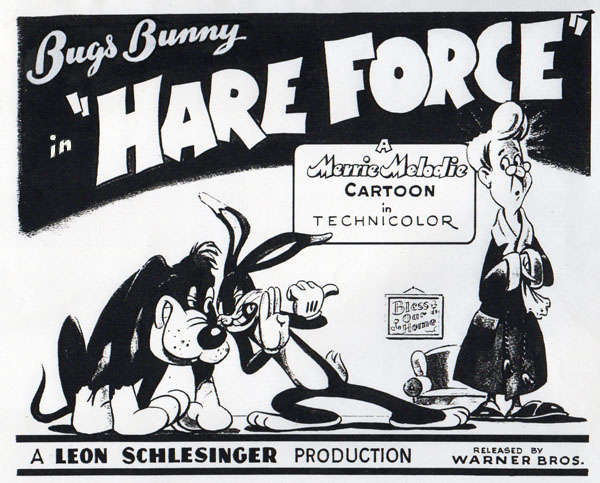
Hare Force (7/22/44) – On a cold and snowy night, a proto-Granny and her dog Sylvester are in a nice warm house. Bugs Bunny wants to get inside to keep from freezing, and wages a typical battle of in-and-out with the dog. vying for that comfortable position by the fireplace (and the chance to toast a few carrots), until Granny’s protests cause them both to give her the heave-ho, and take over the house themselves, leaving her to comment. “Well, I never!“
Songs include “Don’t Sweetheart Me”, a hit for Lawrence Welk and his orchestra on Decca (below), and covered by Blue Barron on Hit, with country versions by Ozie Waters on Coast and Tex Grande on DeLuxe. Vincent Lopez recorded a version on V-Disc for the armed forces. The song also made the international market, by Donald Peers on British Decca, and George Trevare on Australian Regal Zonophone. The song would receive a revisit by Stalling for a vocal rendition by Daffy Duck in Frank Tashlin’s The Stupid Cupid. It would do service again as an opening cue in Hare Do (1949). Also making reappearances are “As Time Goes By” and “The Penguin”.
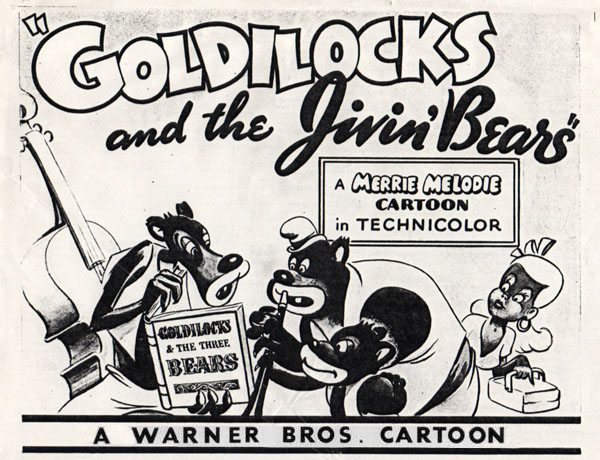
Goldilocks and the Jivin’ Bears (9/2/44) – The tale of Goldilocks is told from the standpoint of a trio of musical black bears – big, middle and little sized rather than Papa, Mama, and Baby – whose musical instruments are getting too hot to touch from their spirited jive playing. The Wolf from Little Red Riding Hood barges in on the story, in quest of Goldilocks. who is a hep “Jitterbug.” The wolf is drawn into a flurry of dancing, too much for hos tender tootsies, and can’t escape it when the bears return with more music, and even Little Red’s Grandma proves she can cut a rug. The footsore wolf is left to give us a Jimmy Durante curtain line: “Umbriago. Everybody wants to get into the act!”
Songs: “Twilight in Turkey”, another notable Raymond Scott composition originally issued on Master records, performed as the main theme by the bears. Tommy Dorsey’s Clambake 7 would give it a whirl on Victor. Stuff Smith would cover the number on Decca. Teddy Hilland his NBC Orchestra would perform on Bluebird. The 52nd Street Boys would cover it on Variety. Ambrose would again get the British version on Decca. “Little Brown Jug” also appears, recorded in or about 1929 by Frank Crumit on Victor. The Blue Ridge Duo would perform a vintage version on Edison Diamond Disc. Henry Whitter would perform it on Okeh, and George Reneau on Vocalion. Then the tune became a swing classic with a new instrumental treatment by Glenn Miller and his Orchestra on Bluebird. Louise Massey would follow suit on Vocalion. Late singles would appear by Art Van Damme on Capitol, Ken Griffin on Rondo and Columbia, an early performance by Floyd Cramer in honky-tonk style on Abbott, Lenny Dee on Decca, and Bobby Gordon on Dot. Also reappearing are “Fountain in the Park”.
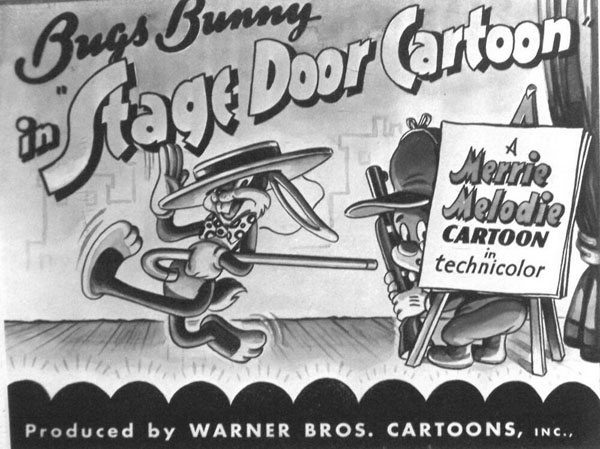
Stage Door Cartoon (12/20/44) – The first of a number of episodes the studio would produce where Elmer chases Bugs into a theatre door, and faces the consequences before a live audience. It also includes a proto-Yosemite Sam, as one of Bugs’ disguises as a southern-fried Sheriff – who somehow turns out to be the real thing after all, dragging Elmer off to the pokey, while the real Bugs conducts from the orchestra pit withe the Jimmy Durante line, “I got a million of ‘em.” The musical score includes “The Latin Quarter”, and “If I Could Be With You (One Hour Tonight)” again, used for a striptease. It also features the first use over the credits of the musical cue (as yet without a lyric” which would be known as “What’s Up Doc?” Another Stalling cue is introduced here in its first use – a sort of “buck and wing” dance number which would recur several times subsequently (including as Bugs’ and Yosemite’s tap dance number in Bugs Bunny Rides Again). Just for fun, here’s the latest rendition of the tune being used on those new HBO-Max Looney Tunes Cartoons:
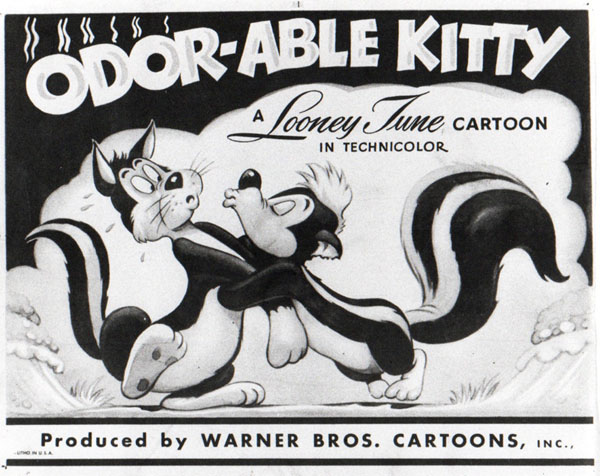
Odor-able Kitty (1/6/45) – The screen debut of Pepe Le Pew. His amorous target for tonight is an alley cat who for once of her own choice adopts the white stripe down the back to fool all the bullies who have pestered and pounded her each day (even using her for a soccer ball). Pepe proves to be a fraud on several levels. His French accent turns out to be a put on, being dropped entirely when a Mrs. Le Pew (actually neither he nor she have an official name yet on screen) and several offspring catch Pepe in the act. And he makes up lame excuses to the Missus, of trying to “remove a cinder from the young lady’s eye”. The wife’s response is a good whomping of Pope with an umbrella, in the tradition of the proverbial wife’s rolling pin. Another notable gag includes a cameo for Bugs Bunny – actually a costume adopted by the alley cat to avoid detection – which is seen through immediately by Pepe. The alley cat decides life as a skunk is too complicated, and goes back to being kicked around, with a smile.
Songs include: “I’m Happy About The Whole Thing”, “It Had To Be You”, Angel In Disguise” and “Time Waits For No One”, which recorded by Helen Forrest on Decca (one of the few companies which had already settled the recording ban). Johnny Long also got a band version on Decca. Woody Herman recorded a version for V-Disc. Sula’s Musette Orchestra would issue a version on Continental. A late revival would issue on Dot by The Hilltoppers. Overseas versions would include George Trevare on Regal Zonophone, Geralso on Parlophone,.and Bill Ternent on Decca. The song would receive vocal reuse in Daffy Duck’s A Pest in the House, and in a speeded up full verse by an ant soprano in “The Gay Anties”.
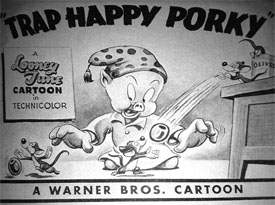 Trap Happy Porky (6/24/45) – Porky is staying at “Uncle Tom’s Cabins – travelers taken (for everything they’ve got)” , but his seep is disturbed by mice cavorting in the kitchen. Porky wonders how he will handle this dilemma, when a cat appears at the door with a sign, “Does this answer your question?” The cat is mechanically inclined, setting up an elaborate Rube Goldberg-style mouse trap (readapted years late with a different payoff for Friz Freleng’s “Tweetie Pie”). However, his work done, the cat’s ulterior motives are revealed, as he invites all his alley-cat friends in for an inebriated party and sing-along around the piano. Porky has to buy a bulldog to deal with this development – but the bulldog is equally susceptible to liquid refreshment, and joins in the party. Porky is left with no recourse but to join in as an extra baritone in the closing chorus.
Trap Happy Porky (6/24/45) – Porky is staying at “Uncle Tom’s Cabins – travelers taken (for everything they’ve got)” , but his seep is disturbed by mice cavorting in the kitchen. Porky wonders how he will handle this dilemma, when a cat appears at the door with a sign, “Does this answer your question?” The cat is mechanically inclined, setting up an elaborate Rube Goldberg-style mouse trap (readapted years late with a different payoff for Friz Freleng’s “Tweetie Pie”). However, his work done, the cat’s ulterior motives are revealed, as he invites all his alley-cat friends in for an inebriated party and sing-along around the piano. Porky has to buy a bulldog to deal with this development – but the bulldog is equally susceptible to liquid refreshment, and joins in the party. Porky is left with no recourse but to join in as an extra baritone in the closing chorus.
Songs: “How Many Hearts Have You Broken?” (heard over the recently rediscovered opening titles), recorded by Stan Kenton on Capitol, Tiny Hill on Decca, Johnny Mercer on V-Disc, and the Three Suns on Hit. Also reappearing are “Moomlight Bay” (again in use for an inebriated quartet, as in “Porky’s Duck Hunt”), and “When Irish Eyes are Smiling”.
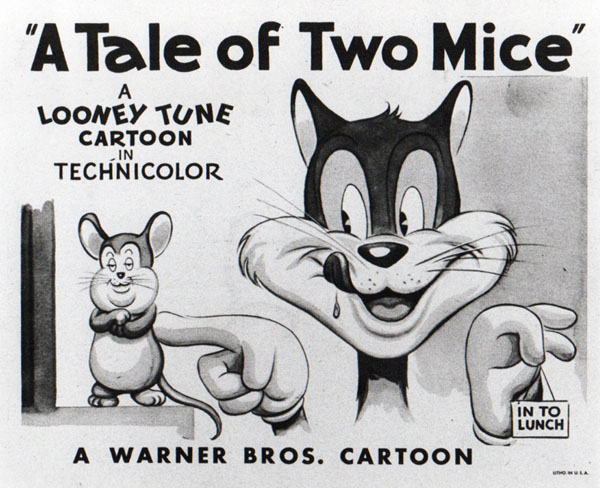
A Tale of Two Mice (6/30/45) – Babbitt and Catstello, now cast as two mice instead of cats, battle with a house cat over the cheese supply, with mechanized tactics such as toy airplanes, rope pulleys, and even a u-ride flat iron. Catstello is only able to get Swiss cheese, which Babbitt claims he doesn’t like. After all the trouble they’ve been though, Catstello determines to make Babbitt like it – by force feeding it down his throat. Songs: First, “A Little on the Lonely Side”, recorded for Decca by Guy Lombardo, by Frankie Carle on Columbia, the Phil Moore Four on Victor, an aircheck by Bing Crosby, and in England by Joe Loss on HMV, Billy Walker on English Decca, Geraldo on Parlophone, and Jimmy Leach and his Organolians on Columbia. Marlene Dietrich also appears to have revived the song in German.
Second, “So Dumb But So Beautiful” from the Warner feature Shine On Harvest Moon, heard here first – and makes future sountrack appearances in Hare Conditioned, Hare Tonic and even under the titles in Feline Frame-Up:
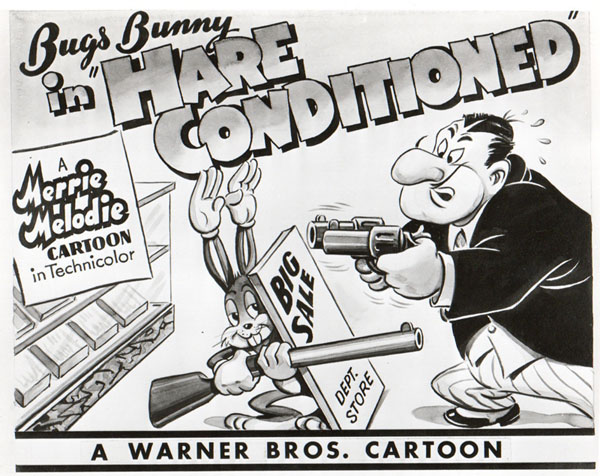
Hare Conditioned (8/10/45) – After doing a gig in the camping section of a department store in live demonstration, Bugs is transferred to a new department by the store floorwalker (a reasonable impersonation of Hal Peary as the Great Gildersleeve). The new department – taxidermy! The resulting chase runs through several major departments, including Ladies’ wear (giving Bugs a chance at female impersonation. “I’d like to see something in a pair ob bedroom slippers.” “Confidentially, so would I”, comments the floorwalker. The chase leads to the roof, where Bugs spins a tale of a guy who had “a horrible Frankincense monster” lurking over his shoulder – then darts behind the floorwalker to make a scarey face, sending him leaping off the roof. Bugs shakes his head at how gullible the guy can be, and makes the same face at himself in a mirror. His reaction – join the floorwalker in a leap off the roof.
Songs: Returning hits include, “You Ought to Be In Pictures” “A Little on the Lonely Side”, and “Oh, You Beautiful Doll”. But most notable is “Sweet Dreams, Sweetheart”, featured by Joan Leslie in the war revue extravaganza, Hollywood Canteen (below), recorded by Stan Kenton on Capitol, Ray Noble on Columbia, Kitty Carlisle on Decca (later of TV fame as regular panelist on To Tell the Truth).

Book Revue (1/9/46) The culmination of Warnet’s fixation with “Midnight in a Book Store” cartoons. Daffy Duck gets involved in the “Little Red Riding Hood” story while performing a dead-on impersonation of Danny Kaye. Borrows some gags from previous book shop cartoons (including the sentence to “Life” (magazine) from “Speaking of the Weather”) – the film in turn was he inspiration for two later television episodes – Tiny Toon Adventures’ Wild Takes Class, where they practice Daffy’s signature take from this film, the “Clampett Cornial”, and “Video Revue”, and updating of the identical premise on the shelves of a video rental store, on “Animaniacs”). The Wolf further turns out to be somewhat effeminate, swooning at Frank Sinatra’s crooning, and sliding into Dante’s Inferno (which book also was used as a venue by a rival studio in MGM’s Good Little Monkeys).
Songs: Returning hits include, “It Had to Be You” (accompanying “Cherokee Strip”, as well as crooned by Sinatra), “Carolina in the Morning”, “La Cucaracha”, and “Dark Eyes”. Under the restored opening titles is “She Broke My Heart In Three Places”, which was recorded by the Hoosier Hot Shots on Decca, and as “HE Broke My Heart In Three Places” by Spike Jones for Standard Transcriptions and on live broadcast.
IN TWO WEEKS: A deeper dive into 1946.


 James Parten has overcome a congenital visual disability to be acknowledged as an expert on the early history of recorded sound. He has a Broadcasting Certificate (Radio Option) from Los Angeles Valley College, class of 1999. He has also been a fan of animated cartoons since childhood.
James Parten has overcome a congenital visual disability to be acknowledged as an expert on the early history of recorded sound. He has a Broadcasting Certificate (Radio Option) from Los Angeles Valley College, class of 1999. He has also been a fan of animated cartoons since childhood.












































The German version of “A Little on the Lonely Side” is called “Wenn der Sommer wieder einzieht” (When summer comes around again). It’s about the romantic hopes for the future that young lovers dream about but never come true. The German lyrics were written by Lothar Metzl, an Austrian playwright and lyricist who worked in musical theatre in Vienna and, after emigrating to America in the thirties, on Broadway. He wrote German lyrics for about a dozen songs that Marlene Dietrich performed in USO shows during the war, including “Wenn der Sommer wieder einzieht”, but apparently she didn’t record it commercially until 1964. After serving in the U.S. Army, Metzl worked in the Office of Strategic Services and later had a long career as a research analyst for the CIA.
My parents liked listening to their German records on Sunday afternoons, but Saturday evenings were always for the Lawrence Welk Show. The Lennon Sisters! Bobby and Cissy! Violinists with forced smiles! “Wonnerful, wonnerful!” A lot of people think “The Prisoner” had the creepiest bubbles on TV in the ’60s. Those people never saw the Lawrence Welk Show.
The “dumb but beautiful” blonde in that musical number from “Shine on Harvest Moon” is Marie Wilson, who later starred in “My Friend Irma” on radio and TV. In the seventies she played Bubba’s wife in the animated Hanna-Barbera primetime series “Where’s Huddles?” (Bubba was voiced by Mel Blanc.)
“Trap Happy Porky” also used “Velvet Moon” by Josef Myrow and Edgar De Lange, also heard in the upcoming “One Meat Brawl” and “Easy Peckin’s”: https://www.youtube.com/watch?v=uddOJ1djl2M
Being a total toon-o-holic (esPESH of 40s WBs)….AND a piano player at a piano bar….this is not only wonderful….but INVALUEABLE!! What a total treat to actually see/hear (alas alas) human” versions of the tunes we know oh so well!! Thank YOU!!!
Regarding “Odor- Able Kitty”, the cat in the cartoon was clearly male, not female.